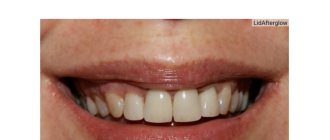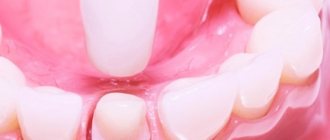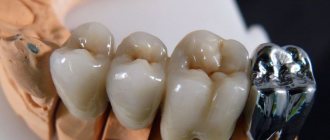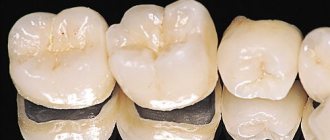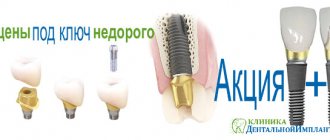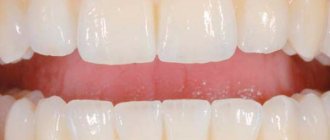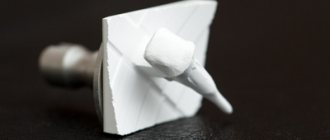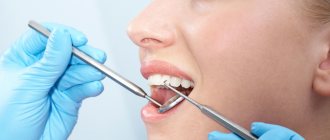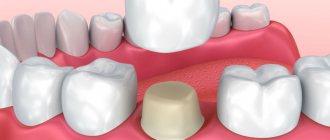A metal-ceramic crown is one of the most successful and economical methods of prosthetics, which is very popular both among dentists themselves and among their patients.
The “metal-ceramic” crown received its name due to the material used. It consists of a metal frame, which is coated on the outside in layers with a special ceramic mass.
The ceramics are distributed over the frame in multilayers. In this case, each subsequent layer is fired at 800-950 degrees in a special oven. This process allows metal and ceramics to enter into a strong chemical relationship, which ensures incredible durability and reliability of the entire structure.
Thanks to modern technologies, a metal-ceramic crown is placed on a tooth completely painlessly, after which a person can appreciate the advantages of this method and the surrounding beauty of your teeth.
Advantages of metal-ceramic crowns
- Pleasant aesthetic appearance;
- Long service life. When using high-quality ceramic mass, on average, crowns can last from 10 to 15 years.
- High strength;
- Nice price. Remember, if you are interested in a metal-ceramic crown, its price will depend on a number of conditions (quality of material, type of fixation, size, etc.). For 2021 in Belarus it ranges from 170 to 650 rubles. We offer the best prices for dental services. The classic installation option will cost less than 200 rubles; a metal-ceramic crown on an implant will cost 550 rubles if cemented and 560 rubles if screwed.
Metal ceramics VS Zirconium dioxide.
frame of metal-ceramic crowns
crown frame based on zirconium dioxide
We have already explained the differences between metal ceramics and ceramics based on zirconium dioxide. In principle, zirconium is the same metal, which is favorably distinguished by its aesthetic properties (white color) and absolute biocompatibility, but is less favorably distinguished by its price. When choosing a material for dental prosthetics in the smile area, it would be logical to give preference to crowns on a zirconium frame. When restoring chewing teeth, it will be cheaper to install metal ceramics. If the patient has metal intolerance, the solution would be to install a prosthesis on a zirconium frame.
What patients who decide to have a metal-ceramic bridge need to know
First and foremost, the installation of a metal-ceramic crown can be done using different methods, and the options for making prostheses may differ, but the main thing in the prosthetics process, on which the reliability, quality, service life and aesthetics of the products will directly depend, is the stage of preparing the teeth. In addition, the procedure of grinding and taking an impression will play an important role here.
1. Endodontic preparation of teeth.
What is meant by these words? This is nothing more than filling root canals. Despite the professionalism of many doctors, it is possible to correctly fill the root canal only in 40-45% of cases. Poor filling causes an inflammatory process and, as a result, it will be necessary to remove the metal-ceramic bridge, re-treat the teeth and begin a new stage of prosthetics. In order to avoid getting into such a situation, it is important after filling the root canals:
- take a control photo;
- get advice from a specialist who, after analyzing the image, will confirm that the teeth preparation procedure was successful.
Attention! We offer 100% high-quality root canal treatment using innovative methods using professional imported equipment and materials. Contacting our specialists will allow you to avoid the occurrence of granulomas and cysts under the crowns, and therefore get adequate preparation of your teeth for the prosthetic process.
2. Preparation (grinding) of teeth for crowns.
A special feature of the process of grinding teeth for crowns is the presence of a special “ledge”. Thanks to this method:
- bacteria and food debris do not accumulate under the crown, creating unpleasant sensations;
- the service life of products is significantly extended;
- The crown is a beautiful extension of the tooth root.
3. Taking impressions.
Even if all of the above points are performed at the highest level, without a competent and professional approach to taking impressions, the procedure for installing crowns will not be of high quality. A-silicone is considered an excellent impression compound, and a polyester composition is an ideal option. The use of such impression materials allows you to accurately replicate the features of the oral cavity.
It is important to know! The slightest dishonesty of the dentist, the use of low-quality materials at the stage of grinding teeth or when taking impressions will lead to the fact that the manufactured product will not fit well to the neck of the tooth. The consequence is the leakage of saliva, the entry of bacteria, and rotting of the teeth under the crown itself.
Types of turning
The choice of technique depends mainly on the individual clinical picture, as well as on the volume of tissue that needs to be trimmed. There are types that are more extended in time, and there are very fast, safe and pass without the slightest pain. Let's look at all of them that currently exist. But keep in mind that the choice always remains with the attending physician, who will assess the situation and select the most optimal option.
Ultrasonic
This method involves the use of a special apparatus that produces high-frequency vibrations - ultrasonic. And the device itself is called a “scaler” or “scaler”. By the way, it is used to clean enamel from plaque. Also, instead of a scaler, a piezo device can be used - its action is again based on the use of ultrasonic waves, but they are more powerful, which allows it to be used on harder tissues.
During the procedure, the doctor does not touch the enamel with the instrument. Almost no heating occurs. So the risk of damage disappears. As for pain, it may well occur if there is increased sensitivity, so anesthesia will be appropriate. The method makes it possible to dissect only a small volume.
Laser
This is another effective non-contact turning method. The laser acts on the enamel pulsed, but again removing only a very small layer of enamel and inner dentin. By the way, unlike ultrasound, this method is safer, since laser beams have a wound-healing effect. The method is absolutely silent and allows you to quickly achieve the desired result.
Preparation with a drill
This technology involves the use of a good old drill and a diamond (or metal) tip . In fact, this is the most common and optimal turning option. The doctor can choose different speeds of rotation of the bur, but to prevent overheating, water must be supplied. In fact, the process is no different from drilling in the treatment of caries - everything is done in a similar way.
Watch the video at the end of the article - you can get an idea of how the process of preparing a tooth cavity using a drill occurs.
Air abrasive method
This technique is based on the use of a jet of water and a composition with abrasive particles. Using an air-abrasive method, the doctor is able to smoothly grind off the required amount of tissue. The patient does not feel pain. There is almost no heating and vibration. But the technique makes it possible to remove, again, only a minimal amount of tissue.
Chemical turning method
This method involves using exclusively active acids. Penetrating into tissues, special compounds destroy them. The doctor will only have to remove the softened areas and give the crown the necessary shape so that it fits well under the future prosthesis or structure. The procedure is not quick. The method is considered outdated and is not often used.
On a note! Thus, in 99% of cases it is drilling with a drill that is used for prosthetics (and not for the treatment of superficial caries). It is this technology that allows you to remove any amount of tissue in an extremely short time. True, anesthesia will definitely be required (except for those cases when the tooth is already “dead”, that is, without a nerve).
Types and colors of metal-ceramic crowns
1. The classic version is based on a frame made of nickel-chromium or cobalt-chromium alloy. Note that despite the cheap cost of such crowns, their reliability and strength remain at the proper level, but the color of the ceramics in this case is soft white without a yellowish tint (somewhat different from real teeth, which have a yellowish tint).
There are:
- Without a ceramic shoulder mass (the cheapest option, in which at the junction of the metal frame with the tooth there is contact between the metal and the gum/oral cavity).
Please note that in the photo the edge of the metal frame is not insulated with ceramics, and therefore the metal will come into little contact with the gum, which in some cases can affect the color of the gum.
- With shoulder ceramic mass (a more expensive option that eliminates metal contact with the gum).
The photo shows a crown for the central upper incisor, made with a shoulder mass (shown by the arrow). Note that the shoulder mass is performed only on the anterior side of the crown, which reduces the cost of the service and is sufficient for good esthetics. In these places, the metal does not come into contact with the gum.
2. Metal-ceramic crowns with a frame made of precious metals.
An example of a crown on a frame containing gold (left) and a classic one based on a cobalt-chromium alloy (right).
Advantages:
- allow you to make a crown as similar as possible to a real tooth (the color of metal-ceramic crowns based on alloys of precious metals is as close as possible to the real one, has a slightly yellowish tint);
- less allergenic, react less with the aggressive environment in the oral cavity.
Unfortunately, due to the high cost of crowns made of precious metals, our clinic does not provide such a service, but offers cheaper, but no less high-quality and reliable alternative options.
3. On a milled metal frame.
The basis of such crowns is made on special machines using innovative technologies, which allows us to obtain high precision of the product, and, consequently, an excellent fit of the crowns to the dental neck. The only disadvantage of this type is the high cost, which is very significant for many patients.
Depending on the type of installation:
- metal-ceramic crown on a pin or on an implant;
- with cement fixation;
- with screw fixation.
Types of Best Dental Crowns for 2022
Modern dentistry offers patients crowns made from various materials. It is this indicator that is key in determining the cost, quality parameters and indications for the use of a particular prosthesis. Another important criterion on which the quality of a product depends is the production method.
The following crowns are currently in demand:
- Metal-ceramic. They are among the most popular prosthetic devices. Includes a metal base and an outer facing layer of ceramics. Initially, the frame is made, after which the ceramic coating is performed. The production process can be carried out on the basis of modern computer programs and aesthetic modeling.
- All-ceramic. In the manufacture of such prostheses, metal-free ceramics are used. Provides maximum safety in relation to soft tissues, which is due to the biological inertness of this material. The manufacturing process is based on the firing technique; ceramic pressing technologies; use of milling equipment and modern digital programs.
- Crowns made of zirconium material. Despite its origin (metal), zirconium dioxide is famous for its unrivaled aesthetics and increased safety. The manufacturing process is based on the use of specialized digital programs and milling equipment. Two versions of such prostheses can be used: combined (include a base of zirconium material and ceramic lining) and monolithic (made of zirconium oxide without the use of a ceramic coating).
- Glass ceramics e.max. It is distinguished by perfect aesthetic parameters and the necessary strength. There are currently 2 material options in use: E.max RPESS - produced by injection molding using elevated pressure and temperature conditions, and E-max CAD - produced using modern digital applications and milling machines (CAD/CAM concept).
How to properly care for metal-ceramic crowns
Ceramic metal requires special attention and care, otherwise its service life is significantly reduced.
Recommendations for caring for metal ceramics:
- After each meal, you should clean the crown well with a soft brush without using abrasives.
- If possible, use irrigators to clean your teeth.
- Eliminate seeds, nuts, and other solid foods from your regular diet.
- Stop smoking and coffee; nicotine and natural coffee lead to rapid darkening of expensive materials.
- Do not combine cold foods with hot foods, such as coffee and ice cream. This leads to the appearance of microcracks on the ceramics.
- Do not consume foods that contain visible dyes.
- Every six months, visit the dental clinic and consult with a specialist.
- If you follow the above fairly simple rules, even the cheapest metal-ceramic prosthesis can serve you for more than 10 years.
Warranty for metal ceramics
A good dental clinic provides a guarantee for metal-ceramic dentures - its period, as a rule, is less than the service life of the structure. If the prosthesis breaks before the warranty period expires, the clinic provides restoration or replacement services free of charge.
Restoration is carried out in case of mechanical damage to the crown - for example, chips. In this case, the prosthodontist assesses the extent of the problem and determines whether the framework of the structure is exposed. Restoration of a small chip that does not expose metal is carried out using composite materials. However, restoration when the frame is exposed may be impossible; the optimal solution here would be to remove the structure and re-prosthetics. In order to prevent unpleasant situations (chipping, crown loss), it is important to promptly replace metal-ceramics after their service life has expired.
It is important to make a choice regarding the type of metal-ceramic structure, taking into account how long you plan to wear the structure. Of course, the best can be considered to be made from a gold-platinum alloy; its service life reaches 15 years, and zirconium dioxide crowns can last even longer with proper care. However, the cost of such solutions will vary.
Metal-ceramic crowns before and after
Metal-ceramic bridges on the front teeth, with a competent approach from a specialist and high quality materials, are in no way different from real teeth. However, it is worth understanding that not every technician is able to make ideal crowns, plus many clients choose the economical option, which is performed using inexpensive ceramics, which, of course, cannot give a result comparable to real teeth. But in any case, crowns provide an excellent aesthetic appearance. For example, here are a few photos before and after prosthetics.
Metal-ceramic crowns for front teeth, before and after photos
Metal-ceramics on chewing teeth, before and after photos
Metal-ceramic bridge for 3 units (in the photo on the left, two abutment teeth are ground for the installation of crowns).
Indications for metal-ceramic prosthetics
A doctor may recommend this method of tooth restoration for the following indications:
- severe tooth decay as a result of caries or injury - the impossibility of restoring it with fillings;
- anomalies of dental development that disrupt the function and aesthetics of the dentition;
- the absence of 2 or more teeth in a row and the presence of supporting teeth on the sides of the dentition defect (cermet bridges can be used here);
- inability or unwillingness to use other prosthetic methods.
Stages of prosthetics using metal-ceramic crowns
The duration of the procedure from the moment of grinding the teeth until complete installation is on average 14 days. It is simply unrealistic to provide high-quality dental services in this area in a shorter time.
Attention! Do not forget that urgency can come at the expense of quality, and therefore you should not ask a specialist to do everything faster.
Stages of therapeutic preparation of teeth and prosthetics
- Taking an x-ray.
- If inflammatory processes are detected, their complete elimination (filling canals, removing caries, replacing low-quality previously installed fillings, in case of serious tooth destruction, screwing in a pin, etc.).
- Grinding of a tooth or teeth, taking into account the thickness of the new crown.
- Obtaining an impression of the dentition.
- Manufacturing of metal-ceramic crowns. This procedure is performed by a dental technician in a dental laboratory. While dentures are being made, the orthopedist can offer his patient the installation of a temporary plastic version for a small fee. This allows you to maintain aesthetics and protect teeth, which, after grinding, are more vulnerable to the effects of the acidic environment present in the oral cavity.
Helpful advice from our orthopedist! If you decide to have prosthetics for your front teeth, installing a crown on the entire dentition looks most attractive. When installing several individual crowns, they will differ slightly in structure and color from your own teeth.
Will it hurt when turning?
The word “grinding” used to sound scary coming from a dentist. Today, the preparation process does not last long and takes place without any discomfort or pain. Before starting the procedure, the doctor will “freeze” the mucous membrane with a special gel, and the patient will not feel the injection with a good local anesthetic at all. Anesthesia is used both in the case of working with living units (in order to “turn off” for a while the nerve that is sensitive to any manipulation) and with “dead” units in which the nerve is absent. After all, turning involves a very painful retraction of the gums.
Disadvantages of metal-ceramic crowns
- Allergic reaction to metal. Before the prosthetic procedure, it is important to consult with a specialist.
- Formation of a metallic taste in the mouth (occurs in less than 5% of patients).
- If installed incorrectly and using low-quality materials, the mucous membranes of the oral cavity may become inflamed.
- Poor aesthetics (often the color of the crown differs from the adjacent natural teeth; it is important to make claims about the color during the fitting process, and not after all the work has been done). In order to avoid this problem, do not chase low prices, choose trusted specialists and higher quality materials.
- With an unprofessional approach to installation, the crown may not fit well, causing the patient to feel discomfort, and in the worst case, the tooth under the crown may rot over time.
- Blueness of the gums at the point of contact with the crown. This problem can be avoided by installing crowns with “shoulder mass”.
- When using cheap, low-quality materials, as well as improper installation, chips can appear on the ceramic very quickly. With a proper approach to the prosthetics process, this problem will not make itself felt for more than 10 years. To avoid chips on ceramics at home, experts recommend eating less nuts and seeds.
Attention! If chips appear on cermets, contact a specialist. Thanks to modern technologies, this problem can be eliminated very quickly directly in the oral cavity without removing crowns.
Metal ceramics VS Metal.
All-metal crowns compare favorably with metal-ceramics in price and are not inferior in structural strength. But there are a few “buts”:
- metal can imitate a natural tooth only in terms of anatomical shape (the “iron teeth” effect);
- metal teeth destroy the teeth they come into contact with, increasing their
What alternatives to metal-ceramic crowns can you choose today?
- When replacing chewing teeth with prosthetics, an alternative method can be the installation of solid metal crowns. This option will be cheaper, plus they are superior to metal-ceramics in their reliability and durability. The disadvantage of this type of prosthetics is aesthetics.
- For prosthetics of the front row of teeth, metal-free ceramics can be an excellent alternative. This material looks more aesthetically pleasing.
- Combined prosthetics.
In the photo, metal-ceramic crowns are combined with solid metal crowns.
This method can be used if, for example, you are going to make a bridge for three, four or more teeth and one or more prosthetic teeth extend out of the smile zone (not visible). In this case, metal ceramics are placed on the visible teeth, and classic solid metal crowns are placed on the remaining teeth.
The combined option will slightly reduce the cost of the service, but without harming the client.
If you are interested in dental prosthetics, you can get a free consultation with an orthopedic dentist, as well as other specialists, with us today! We will be happy to help you, provide high-quality materials, provide an individual approach to each client and guarantee the quality of our work.
What is cermet?
When we say “metal-ceramics,” we most often mean crowns and bridges on a metal frame coated with ceramic. Otherwise, it is an orthopedic base made of metal, repeating the shape of a tooth ground for a crown, which is covered on top with a layer of thin ceramics. Ceramic metal is less likely than other materials to cause allergies. Metal-ceramics are used mainly for dental prosthetics in the chewing region, where preference is given not so much to aesthetic qualities as to reliability and functionality.
Advantages of seeking prosthetics at the KRAVMED clinic
- We use only high-quality materials and the latest crown manufacturing technologies, which avoids side effects and makes it possible to obtain a prosthesis that best suits the shape of the ground tooth.
- For veneering metal-ceramic crowns, only premium imported ceramic masses are used. They have high strength, reliability, and aesthetics.
- When taking impressions, our specialists use only high-precision A-class silicone impression mass. In this case, it is possible to obtain the most accurate relief of the dental cavity and produce a high-quality crown.
- To fix finished crowns, we use high quality materials, which is confirmed by relevant certificates.
- By collaborating with ceramic mass manufacturers and gaining work experience abroad, we independently produce crowns using the most modern methods and use the best practices in the world.
- The dental technicians working in our clinic are high-level specialists and have more than 10 years of experience in their industry. By contacting us for help, you can really get what you dreamed of - beautiful, durable, reliable metal-ceramic crowns.
We will be glad to see you among our clients! We invite you to sign up now for a free consultation with our orthopedic dentist.
What is preparation
At its core, the preparation process involves removing part of the hard tissue. This layer, represented by enamel (the outer shell) and dentin (these are the internal tissues), must be equal to the thickness of the prosthesis. Armed with a bur, the doctor cuts off the excess and gives the crown the shape on which the prosthesis will easily and reliably fit. It is important to ensure maximum density and absolute accuracy of its fit. As a rule, the shape of a natural tooth is a cone or cylinder.
Relatively speaking, you will have to “cut off” the amount that is equal to the thickness of the prosthesis. For example, zirconium dioxide will require minimal grinding, but metal-ceramics (after all, there are both ceramics and metal) will require the removal of a thicker layer of living tissue.
Preparation is also carried out during filling, but in this case only inflamed tissues are removed, while healthy ones are preserved. If you need to install a prosthesis, even living tissue will have to be removed.
Completion of prosthetics
All restorations are veneered according to the same scheme as for demonstration crowns. In the partially fired state, several preliminary fittings of the restorations were carried out, followed by corrections of their structure, until we were able to achieve a result that satisfied all interested parties. The final correction of the occlusion was also carried out during preliminary fitting, so that after glaze firing and final fixation of the crowns, no further mechanical processing was required.
As a result, we produced permanent restorations with a total length of 28 units. Forming a ceramic shoulder, individual veneering, creating an individual surface texture and finishing correction before glaze firing takes a lot of time, but the end result is completely worth all our efforts.
Soft tissue augmentation was performed in the area of tooth 22 to stabilize the weakened gums and prevent further gum recession.
How painful is the procedure?
The procedure is unpleasant psychologically, but the preparation will be carried out only after the doctor gives you anesthesia - the anesthetic is given even when the grinding is minimal or when the tooth is already “dead”, i.e. it lacks a nerve. This will help you feel absolutely no pain or discomfort in the dentist’s chair. True, some patients, after the effect of anesthesia wears off, note the occurrence of pain reactions. In most cases, pain occurs when a sufficiently large layer of tissue is removed, i.e. before prosthetics with crowns or bridges. Then this is a natural phenomenon that is associated with interference in the living tissues of the body. After all, during the preparation, the doctor used a drill, which heated the tissue and pushed back the gum in order to create a ledge.
The unpleasant sensations should pass soon, but if they continue to bother you for more than 3-5 days and increase in intensity, then be sure to see a doctor. Perhaps the specialist made mistakes when grinding hard tissues, which resulted in an inflammatory process.
How much will the turning cost?
The cost of dental preparation differs depending on the economic policy of the clinic.
But in most situations, no one highlights it as a separate service - it is simply included in the overall price of prosthetics. That is, for example, if installing a ceramic crown costs 20 thousand rubles, this implies that the price also includes preparation. But sometimes you will have to pay an additional 500 to 2000 rubles for a temporary crown, which is placed on a ground tooth to protect it. Not all clinics operate on an all-inclusive basis, so you definitely need to clarify what exactly is included in the price of prosthetics. Belenchikov A. A., Biragova A. K., Epkhiev A. A. Assessment of changes in the microstructure of hard dental tissues after preparation with various types of burs. Journal of health and education in the 21st century, 2022. [ii] Vedernikova L. V., Zholudev S. E. Planning the aesthetics of ceramic veneers without preliminary tooth preparation, 2013.
